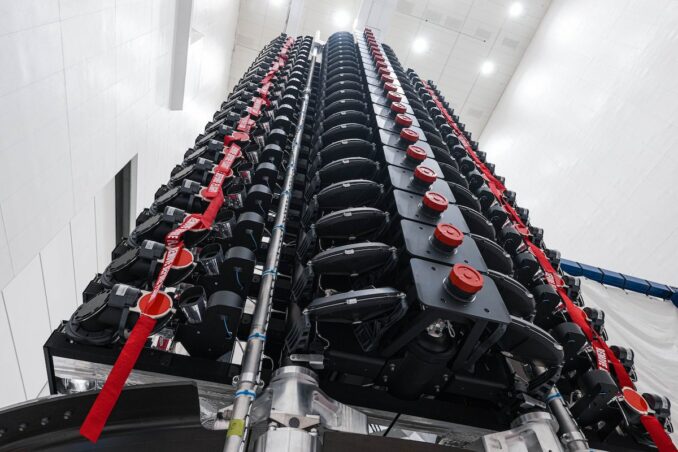Space News & Blog Articles
Live coverage: SpaceX to launch 24 Starlink satellites on Falcon 9 rocket from Cape Canaveral
 File photo of Starlink V2 Mini satellites being prepared for launch in a payload processing facility at Cape Canaveral. Credit: SpaceX
File photo of Starlink V2 Mini satellites being prepared for launch in a payload processing facility at Cape Canaveral. Credit: SpaceX
SpaceX is preparing to launch its biggest batch of second generation Starlink satellites to date on Saturday. The company loaded 24 Starlink V2 Minis onto its Falcon 9 rocket, which is preparing for flight at Space Launch Complex 40 at Cape Canaveral Space Force Station.
Liftoff of the Starlink 6-39 mission is set for 6:41 p.m. EST (2341 UTC). This will be the 11th dedicated Starlink launch so far in 2024 and includes one more second-generations Starlink satellite than Falcon 9 has carried on recent flights. It’s not clear if SpaceX has achieved this extra capacity by squeezing more performance out of the Falcon 9 vehicle, modifying the flight profile or reducing the mass of each satellite. The first V2 mini delivery mission on Feb. 27, 2023 carried 21 satellites. SpaceX increased the capacity for each Cape Canaveral launch to 22 satellites in May, before raising that number again to 23 in October 2023.
Spaceflight Now will have live coverage starting about one hour prior to liftoff.
About eight and a half minutes after liftoff, the Falcon 9 first stage booster, tail number 1069, will land on the SpaceX droneship, ‘A Shortfall of Gravitas.’ This will be the 59th landing on this droneship and the 215th droneship landing to date.
The Starlink satellites are set to deploy from the Falcon 9 upper stage a little more than an hour after liftoff and will bring the total number of Starlink satellites launched to 5,896, according to statistics tracked by astrophysicist Jonathan McDowell.
Destination landings
The Starlink 6-39 mission comes on the heels of a new international partnership with The Bahamas.
The Bahamas Ministry of Tourism, Investments & Aviation (MOTIA) announced a Letter of Agreement (LOA) with SpaceX on Tuesday that helps pave the way for the company’s East Coast-based droneships to be stationed east of The Exumas for booster landings.
MOTIA said that this will set up “exclusive visibility of rocket landings” from areas around The Bahamas that would make it a “destination as the only one of its kind worldwide.”
“This Letter of Agreement with SpaceX marks a new era for The Bahamas. We are honored to work with SpaceX to enable their Falcon 9 rockets to safely land on an autonomous droneship within Bahamian waters, helping to continue their rocket reusability efforts,” said Hon. I. Chester Cooper, Deputy Prime Minister and Minister of Tourism, Investments & Aviation in The Bahamas, in a statement.
“Simultaneously, through Starlink’s high speed internet from space, this agreement opens doors to unprecedented opportunities for our citizens, fostering long-term advantages for education, emergency response and innovation,” Cooper said. “The Bahamian Government aims to utilize this partnership for economic growth, job creation and enhanced educational opportunities.”
Starlink internet access was first established in The Bahamas back in August 2023. Members of the Bahamian delegation visited SpaceX headquarters on Monday prior to the announcement of the LOA, according to Kiko Dontchev, vice president of launch for SpaceX in a post on X.
Mega exciting to see the announcement of the letter of agreement between @SpaceX and the Bahamas! This will enable falcon to land in Bahamian territorial waters and hopefully provide awesome droneship landing viewing opportunities. A huge shout out to @arbowe and @opmthebahamas… pic.twitter.com/JRmqUNd5Z6
— Kiko Dontchev (@TurkeyBeaver) February 21, 2024
Philip Brave Davis, the prime minister of The Commonwealth of The Bahamas, stated on X that this agreement also “will provide greater connectivity for our schools and enhance the capabilities of our first responders.”
For SpaceX the new landing zone will allow it to optimize trajectories for launches into orbits requiring more southerly trajectories. This will minimize ‘dog leg’ maneuvers required to skirt the Bahamas and giving the Falcon 9 the performance to carry more Starlink satellites.
The Starlink 6-39 mission will see its first stage booster land east of The Bahamas, in a location previously used for this group of Starlink satellites.
When you subscribe to the SpaceZE News Feed, we will send you an e-mail when there are new updates on the site so you wouldn't miss them.

